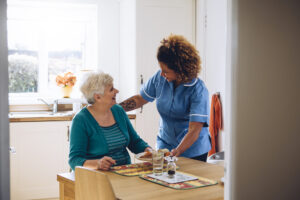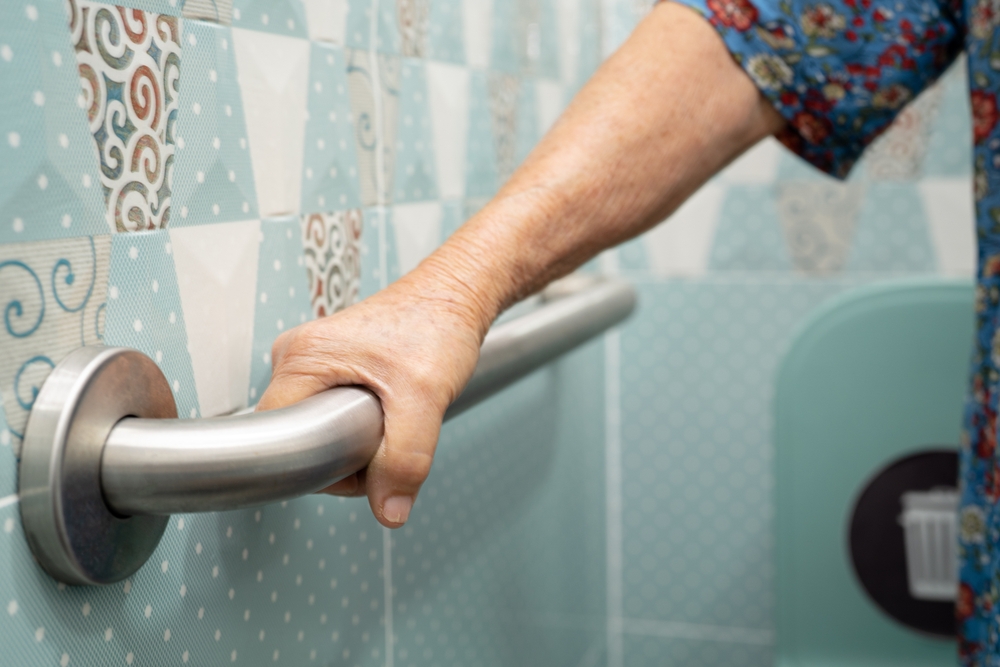The bathroom may be one of the smallest rooms in a home, but for seniors, it can be one of the most dangerous. Slippery surfaces, hard edges, and limited mobility all contribute to a high risk of falls and injuries. For older adults who wish to age in place, making bathroom safety a priority is essential.
At Americare, we believe that safety and independence can go hand-in-hand. With a few thoughtful, often simple modifications, caregivers can help their loved ones move more confidently and securely through daily routines. This guide will walk you through practical and affordable ways to improve bathroom safety for seniors, plus the support you can get to ensure every aspect of in-home senior safety is covered.
Why Bathroom Safety Matters for Seniors
Fall Risks in the Bathroom
The combination of water, smooth tiles, and frequent transitions between sitting and standing makes bathrooms a top spot for falls among older adults. Tasks like stepping into a tub, rising from the toilet, or reaching for a towel can all become fall hazards without the right support systems in place.
Even healthy seniors with good balance can be vulnerable to slipping or losing footing. For those with arthritis, vision problems, or limited mobility, the risks are even higher. That’s why bathroom safety modifications are a key part of fall prevention.
Statistics on Senior Injuries at Home
According to the CDC, nearly 80% of falls among older adults happen in the bathroom. These incidents can result in serious injuries such as hip fractures, head trauma, and long-term loss of independence.
Top 5 Senior Bathroom Modifications to Improve Safety
 The good news is that many of these bathroom-related accidents are easily preventable with some forward-planning and a few cost-effective changes.
The good news is that many of these bathroom-related accidents are easily preventable with some forward-planning and a few cost-effective changes.
1. Install Grab Bars and Handrails
One of the most effective ways to increase bathroom safety for seniors is to install grab bars in key areas like beside the toilet, inside and just outside the shower or tub, and along walls where extra support may be needed.
Grab bars provide stability when sitting, standing, or moving around wet surfaces. Choose bars with textured, non-slip grips and ensure they’re properly anchored into wall studs, not just drywall. Avoid towel racks as substitutes; they’re not built to support body weight.
2. Use Non-Slip Mats and Flooring
Slips on wet tile are a common cause of falls. Here are some easy ways to reduce this risk:
- Place non-slip mats or strips inside the shower or bathtub.
- Add a non-slip rug just outside the tub to absorb excess water.
- If possible, consider upgrading the bathroom flooring to a textured, slip-resistant material like vinyl or rubber.
These simple changes help create a more secure footing, especially when getting in and out of the bath or shower.
3. Upgrade to a Walk-In Shower or Tub
Traditional bathtubs can be difficult and dangerous to enter and exit. Walk-in showers or tubs are designed with seniors in mind, with low or no high edges to step over, built-in seating for safer bathing, and handheld shower heads for added convenience and control.
This is one of the more significant senior bathroom modifications, but the long-term safety benefits can outweigh the upfront cost.
4. Adjust Toilet Height or Add Support Frames
Standard toilets may be too low for some seniors, making sitting and standing challenging. Two options to improve comfort and safety:
- Raised toilet seats increase the height, reducing strain on knees and hips.
- Toilet safety frames provide sturdy armrests on either side for added balance.
These added measures help seniors maintain independence in the bathroom while reducing fall risk.
5. Improve Lighting and Visibility
Good lighting is often overlooked in bathroom safety for seniors, but it plays a critical role in preventing falls and confusion — especially for those with vision impairments or cognitive challenges like dementia. Bathrooms often have shadows, glare, or dim corners that can obscure hazards like water spills or bath mats.
To enhance visibility and create a safer environment:
-
Install bright, glare-free LED lighting
Choose daylight-balanced bulbs that mimic natural light and reduce eye strain. Avoid overly cool or warm lighting, which can distort color and make surfaces harder to judge.
-
Add motion-sensor nightlights
These are especially helpful for seniors who get up during the night to use the bathroom. Motion-activated lights along hallways and inside the bathroom reduce the need to fumble for switches and provide a clear path without being disruptive to sleep.
-
Use contrast to aid depth perception
Vision changes with age, and contrast helps seniors distinguish between objects and surfaces. Place dark-colored mats on light tile or vice versa, and choose toilet seats or grab bars in a contrasting color to the walls for easier visibility.
- Ensure switches are accessible
Consider installing rocker-style switches or motion sensors for those with arthritis or limited dexterity. Place light switches at the entrance to the bathroom at a height that’s easy to reach, even from a wheelchair.
Thoughtful lighting design is a low-cost yet high-impact way to improve bathroom safety for seniors. Combined with other aging in place home modifications, proper lighting can make daily routines feel less stressful and significantly reduce fall risks.
Affordable DIY vs. Professional Modifications
Budget-Friendly Safety Tools
Not all bathroom upgrades require a major renovation. Some low-cost DIY tools include:
- Tension-mounted grab bars (for temporary use)
- Suction-cup bath seats (ideal for travel or rental homes)
- Toilet seat risers
- Non-slip decals for tub floors
These options are widely available online or at hardware stores and can make a big difference for caregivers seeking practical solutions.
When to Hire a Pro
While many modifications can be done DIY, some situations call for expert help, especially if you’re remodeling the shower or changing plumbing. You might also call in a professional if structural reinforcement is needed for grab bars.
If you’re unsure how to adapt your space for your loved one’s specific medical needs, a home healthcare agency like Americare can guide you through aging in place home modifications, and recommend trusted professionals who understand senior safety. We’ll help assess your loved one’s needs and find the right balance between cost, convenience, and safety.
How In-Home Care Supports Bathroom Safety
Modifications alone aren’t always enough. The presence of a trained home health aide can add another layer of support and peace of mind.
Supervised Bathing Assistance
Many seniors feel vulnerable during bathing. In-home caregivers can:
- Assist with getting in and out of the shower safely
- Help with washing and rinsing while preserving dignity
- Monitor for signs of dizziness, fatigue, or difficulty breathing
For those with chronic conditions or balance issues, having someone nearby during bath time greatly reduces the risk of accidents.
Ongoing Risk Assessments by Home Health Aides
Professional caregivers don’t just assist — they observe. As part of their role, Americare’s home health aides regularly evaluate:
- Whether current modifications are still effective
- If a senior’s mobility or vision has changed
- Potential hazards like clutter, wet floors, or worn-out mats
These ongoing assessments are a crucial part of preventing injuries and supporting a safe, evolving care plan.
Personalized Care Plans from Americare
Every senior is different. That’s why Americare offers customized care plans that reflect the individual’s unique health status, preferences, and living environment. Whether your loved one needs help with personal hygiene or more comprehensive mobility support, we’re here for your safety and health.
How Americare Can Help
Preventing falls doesn’t have to mean a full home renovation. By making smart, focused changes like adding grab bars, improving lighting, or upgrading to a walk-in shower, you can dramatically reduce the risk of injury and help your loved one feel secure at home.
At Americare, we’ve helped countless New York families navigate aging in place with compassion and expertise. From home assessments to daily caregiving, we’re here every step of the way.
Get Started With Americare

